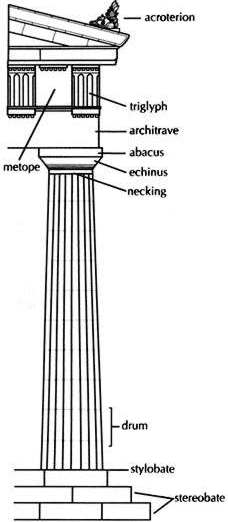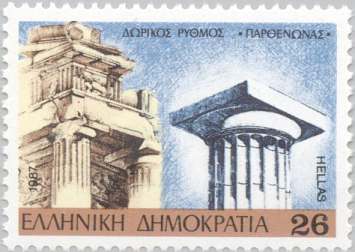.
Wishing to set up columns in that temple, but not having rules for their symmetry, and being in search of some way by which they could render them fit to bear a load and also of a satisfactory beauty of appearance, they measured the imprint of a man's foot and compared this with his height. On finding that, in a man, the foot was one sixth of the height, they applied the same principle to the column, and reared the shaft, including the capital, to a height six times its thickness at its base. Thus the Doric column, as used in buildings, began to exhibit the proportions, strength, and beauty of the body of a man. Vitruvius
The Doric order mainly used by the Dorians (southern Italy and Sicily "Magna Graecia") and in Athens (Parthenon). Some characteristic elements are the triglyphs and metopes and the column capitals ( with the convex echinus and the square abacus)

The Doric columns are carved with channels called flutes (usually 20) these channels meet in sharp ridges (so called arrises) whereas in the Ionic order they are separated by bands (fillets) and the flutes are deeper.

A characteristic elements of the Doric order: the Triglyphs and the usually decorated Metopes

(Parthenon Example), Mainland Greece and Magna Graecia (Italy), No column base like in Ionic or Corinthian Order
Doric Order
| Ancient Greece
Science, Technology , Medicine , Warfare, , Biographies , Life , Cities/Places/Maps , Arts , Literature , Philosophy ,Olympics, Mythology , History , Images Medieval Greece / Byzantine Empire Science, Technology, Arts, , Warfare , Literature, Biographies, Icons, History Modern Greece Cities, Islands, Regions, Fauna/Flora ,Biographies , History , Warfare, Science/Technology, Literature, Music , Arts , Film/Actors , Sport , Fashion --- |
Retrieved from "http://en.wikipedia.org/"
All text is available under the terms of the GNU Free Documentation License

